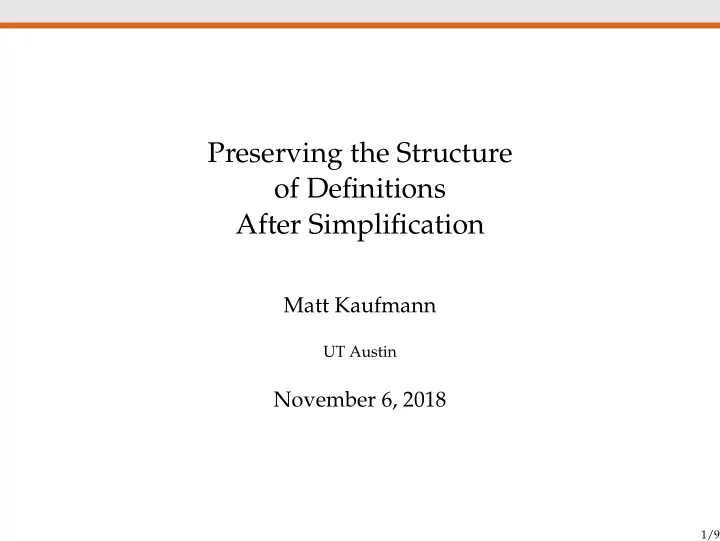

Preserving the Structure of Definitions After Simplification Matt Kaufmann UT Austin November 6, 2018 1/9
THE PROBLEM 2/9
THE PROBLEM Task : Simplify definitions (largest single task during my three-year collaboration with Kestrel; part of their APT tool suite) 2/9
THE PROBLEM Task : Simplify definitions (largest single task during my three-year collaboration with Kestrel; part of their APT tool suite) Goal : Preserve structure when simplifying definitions 2/9
THE PROBLEM Task : Simplify definitions (largest single task during my three-year collaboration with Kestrel; part of their APT tool suite) Goal : Preserve structure when simplifying definitions Approach : Directed-untranslate 2/9
THE PROBLEM Task : Simplify definitions (largest single task during my three-year collaboration with Kestrel; part of their APT tool suite) Goal : Preserve structure when simplifying definitions Approach : Directed-untranslate Problem : Reconstruct LET , LET* , and MV-LET (and B* ) after they are expanded away by simplification. 2/9
THE PROBLEM Task : Simplify definitions (largest single task during my three-year collaboration with Kestrel; part of their APT tool suite) Goal : Preserve structure when simplifying definitions Approach : Directed-untranslate Problem : Reconstruct LET , LET* , and MV-LET (and B* ) after they are expanded away by simplification. Solution : Make separate calls to the ACL2 rewriter while descending through the top-level IF and LAMBDA calls of the definition’s body. 2/9
EXAMPLE (include-book "simplify") (defun app3 (x y ign) (declare (ignore ign)) (append x y)) (defstub f1 (x) t) (defun f2 (x) (f1 x)) (defun g (u) (let* ((temp (f2 u)) (v temp)) (app3 u v 17))) 3/9
EXAMPLE (include-book "simplify") (defun app3 (x y ign) (declare (ignore ign)) (append x y)) (defstub f1 (x) t) (defun f2 (x) (f1 x)) (defun g (u) (let* ((temp (f2 u)) (v temp)) (app3 u v 17))) ACL2 !>(simplify g) (DEFUN G$1 (U) (DECLARE (XARGS :GUARD T :VERIFY-GUARDS NIL)) (LET* ((TEMP (F1 U)) (V TEMP)) (APPEND U V))) (DEFTHM G-BECOMES-G$1 (EQUAL (G U) (G$1 U))) 3/9 ACL2 !>
(rewrite-augmented-term-rec aterm ; augmented term alist hyps geneqv thints runes ctx state) (generalize-to-lambda formals rewritten-actuals rewritten-body) 4/9
(rewrite-augmented-term-rec aterm ; augmented term alist hyps geneqv thints runes ctx state) (generalize-to-lambda formals rewritten-actuals rewritten-body) (trace$ (apt::rewrite-augmented-term-rec :entry (cons traced-fn (take 2 arglist)) :exit (car (cadr values))) (apt::generalize-to-lambda :entry (cons ’generalize-to-lambda arglist) :exit (cons ’generalize-to-lambda values))) 4/9
Recall: (defun g (u) (let* ((temp (f2 u)) (v temp)) (app3 u v 17))) 5/9
Recall: (defun g (u) (let* ((temp (f2 u)) (v temp)) (app3 u v 17))) 1> (APT::REWRITE-AUGMENTED-TERM-REC ((LAMBDA (TEMP U) ((LAMBDA (V U) (APP3 U V ’17)) TEMP U)) (F2 U) U) NIL) .... <1 ((LAMBDA (TEMP U) ((LAMBDA (V U) (BINARY-APPEND U V)) TEMP U)) (F1 U) U) 5/9
ACL2 !>(untranslate ’((LAMBDA (TEMP U) ((LAMBDA (V U) (BINARY-APPEND U V)) TEMP U)) (F1 U) U) nil (w state)) (LET* ((TEMP (F1 U)) (V TEMP)) (APPEND U V)) ACL2 !> 6/9
1> (APT::REWRITE-AUGMENTED-TERM-REC ((LAMBDA (TEMP U) ((LAMBDA (V U) (APP3 U V ’17)) (F2 U) U) NIL) 2> (APT::REWRITE-AUGMENTED-TERM-REC ((LAMBDA (V U) (APP3 U V ’17)) TEMP U) ((TEMP F1 U) (U . U))) 3> (APT::REWRITE-AUGMENTED-TERM-REC (APP3 U V ’17) ((V F1 U) (U . U))) ... <3 (BINARY-APPEND U (F1 U)) <2 ((LAMBDA (V U) (BINARY-APPEND U V)) (F1 U) U) 7/9
2> (APT::REWRITE-AUGMENTED-TERM-REC ((LAMBDA (V U) (APP3 U V ’17)) TEMP U) ((TEMP . (F1 U)) (U . U))) 3> (APT::REWRITE-AUGMENTED-TERM-REC (APP3 U V ’17) ((V F1 U) (U . U))) <3 (BINARY-APPEND U (F1 U)) 3> (GENERALIZE-TO-LAMBDA (V U) ((F1 U) U) (BINARY-APPEND U (F1 U))) <3 (GENERALIZE-TO-LAMBDA ((LAMBDA (V U) (BINARY-APPEND U V)) (F1 U) U)) ; (let ((v (f1 u))) (append u v)) <2 ((LAMBDA (V U) (BINARY-APPEND U V)) (F1 U) U) 8/9
CONCLUSION An old lesson but a good one.... 9/9
CONCLUSION An old lesson but a good one.... If an approach is problematic, try another approach! 9/9
CONCLUSION An old lesson but a good one.... If an approach is problematic, try another approach! DUH? 9/9
CONCLUSION An old lesson but a good one.... If an approach is problematic, try another approach! DUH? If an approach (like trying to use directed-untranslate to reconstruct LET forms) is problematic, try another approach (like orchestrating calls to the rewriter that support such reconstruction)! 9/9
Recommend
More recommend